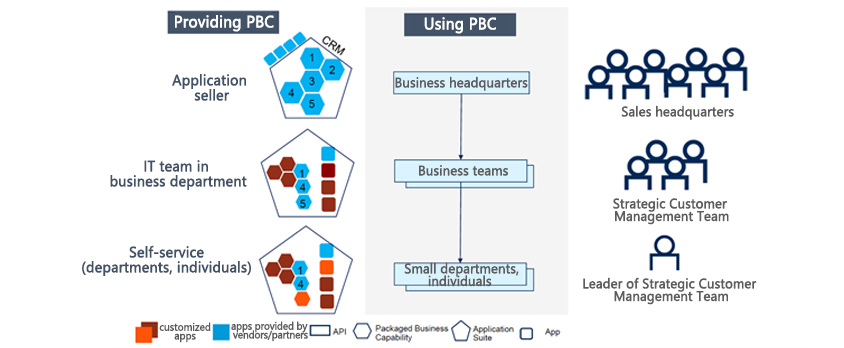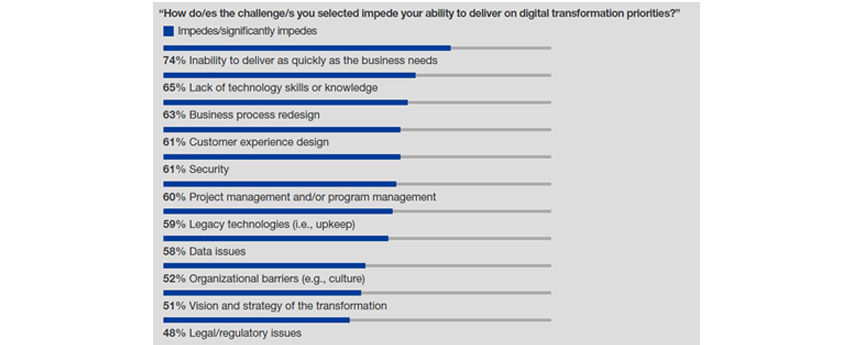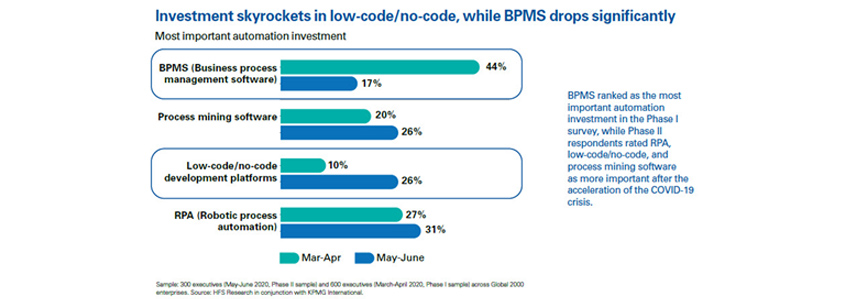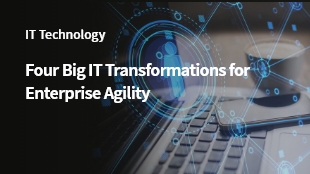
It’s been a while since the word “agile” became a buzzword with the new goal of digital transformation in all companies. But it doesn’t quite get across what it means to be agile or what impacts it can bring to the company. It’s also not quite clear if being agile simply means to own a process to deliver products or services rapidly, or to have a strong, practical influence on profits through organizational innovation.
Conventional corporate organizations, where stability is the best value, consist of static, siloed structures. Goals and decision-making flows downwards and the most powerful governance exists at the very top. These organizations are operated with plans and controls to establish values of profit based on stability. Such structures may be strong, but they are slow to change.
On the contrary, organizations with agility are designed with both stability and dynamicity. It consists of team networks whose characteristics are rapid learning and short decision-making cycles with the common goal of creating value for all stakeholders across technologies. These agile operation models enable the reconstruction of strategies, structures, processes, and personnel with value and efficiency. Agile companies should be able to rapidly convert current priorities into opportunities for value creation. One general misunderstanding about agility for companies is that stability and scale are sacrificed for speed and flexibility. But a real agile company has organically combined both instead of giving up on one of them.
During the agility innovation process, the impacts of defining necessary changes to IT work, which is the digital tower of the company, on the competitiveness and profit shall be manifested through various indices a while after.
The appearance of innovative digital companies, also called the digital natives, over the last 10 years, has shown previous leading companies that they need to change their fundamental business operation models for faster speeds, a more flexible user experiences, and high-quality services to survive. In reality, existing companies find it hard to provide high-quality digital services while creating products through conventional processes, technologies, and personnel. On the other hand, new companies equipped with new digital technologies have invaded the market by rapidly and conveniently providing mobile-first services and next-level user experiences. This phenomenon is very clear in conventional services, such as personal finance or commerce.
Being agile in IT business indicates the level of business capability. The capabilities include speed, quality, and user experience that can compete with digital natives, on top of business speed, productivity, and efficiency to win in the existing market system. The numerous customer experiences and business processes they established so far are what the digital natives lack, and structural changes that can turn them into strengths can be their main business capabilities.
The changes shall secure competitiveness through joint leadership between the business and IT. Agile organizations that have such competitiveness shall have clear distinctions as follows:
• All members have clear organizational goals.
• They have authorities to perform business capabilities and have transparent communications.
• They engage in learning and sharing rapid decisions and new experiences.
• They actively introduce and apply next-generation technologies.
The engine to having such distinctions is to have a business-oriented IT system. Let’s see the four big transformations at the center of the process.
1. Collaboration
From the perspective of the Chief Operating Officer (COO), who is in charge of housekeeping in the company, IT groups have many delayed projects with budget overruns and leave extremely negative impressions in terms of productivity. On the other hand, from the perspective of the Chief Information Officer (CIO), who takes charge of the company's overall digital strategies, they talk about how ever-changing requests from other business departments exceed the responsiveness of the IT department, and that those new requests take a lot of time and manpower. If the process requires defining and adjusting business and IT requests among departments, it could take months for it to actually be implemented in a conventional organizational structure.
Understanding different points of view requires new cooperation models. Isolated IT departments that handle requests should transition into fusion teams (multifunctional team) of business lines and IT experts. Most importantly, work process should be set for the amount or number that can be guaranteed for implementation. After then, the team should be able to perceive the effect of the fusion team itself by enhancing the speed of combining development, release, and feedback. The team becomes a “BizDevOps” fusion team that consists of 5-9 experts who comprise the technologies for the missions (business, development and test, and site operation).
The business team includes product managers (owners), product experts, and customer experience experts, who take a lead in product requirements based on customer voices and ROI. The engineering is divided into developers who lead the service delivery and operators who respond to customers while driving continuous releases and automation stably after delivery. Sharing the status on the same topic and goals to achieve helps the team shorten the time needed to adjust requirements and fundamentally reduce delays in market releases or communications.
What is also important is that the BizDevOps fusion team supports other parts of the business in parallel instead of conducting only one project in the given timeline. The members in one team are not assigned to fixed positions, but the experts are gathered or dissolved organically, so that they can work for multiple teams simultaneously. This creates an engineering-oriented expert team that provides results for certain business segments and a business-based expert team that develops product composition based on features or users. Furthermore, there comes a need for a common service platform team that handles architecture and IT expense efficiency to optimize the autonomy of the segments or products. Once these become processes, the general collaborative pipeline, including DevSecOps, DataOps, or AlOps that provide tools for self-services in all work processes, is established.
Such collaborative structure does not require the department in charge of previous IT work. BizDevOps with its experts escapes from the silo and draws competitive results with rapid decision-making and autonomy.
2. Application service
The legacy systems of general companies are mostly monolithic. A system should be subdivided into microservices small enough to be developed independently, while these microservices are reorganized in a composable form, so that the composition may be free and flexible with business requests.
For example, the conventional core banking system is monolithic, and interconnection is made in one application structure. This structure is good when it comes to size or calculation speed, but when there is a change in one little feature, all other features need to be tested to verify overall quality, and the dependency should be checked. Also, such systems find it hard to accommodate new and more complicated digital channels, such as mobile, web, or partner API, which are new communication channels. For instance, if a bank changes the tariff or supports a mobile client, dozens of systems should be changed in order, which requires parallel development from many departments with quality tests from each department for weeks. However, switching all of the core systems into microservices creates time and cost issues.
Companies use an approach called the “Strangler Pattern” to resolve them. This approach selects the most frequently changed features, assigns ownership to these features to the business team, and makes an exclusive BizDevOps team to turn them into subdivided, specialized microservices. Such services follow the principle of “one service-one feature” and make the legacy core simpler by taking them out of the legacy system. Basically, this approach avoids developing or modifying all the features and can relatively quickly switch. That is, as for the banking services, the basic features of the banking system are still in the core and to be maintained, but the non-core features are separated as microservices or special applications for frequent, easy changes. This approach enables structures that can reduce time for releasing new features in the market, leading to reinforced digital competitiveness.

- ESB : CRM / ERP
- Integrated Packaged Applications
- Numerous networked services
- Mesh Apps and Services(MASA)
- ERP
- Composable Business Applications
In addition, if you want to secure even stronger competitiveness, try transitioning into packaged business capabilities (PBC) where microservices are packaged based on business functionality. It’s a concept of combining modularized services to fit the business processes and making them work as one little package. It’s an approach that provides combinations as per the business priorities while sparing excellent technological architectures of the microservices. The new type of companies quickly adapt to the changing customer realities and requirements and do not depend on the previously used single type of technologies. In other words, the IT system that is the basis of a composable company is dispersed, but cooperative. In the past, the architecture of a corporate IT system performed responsive tasks, such as system order and building, writing and providing reports, or resolving system issues to meet the requirements. However, the IT system in a new composable company performs proactive suggestions and encourages innovations on top of the previous roles. A lot of the services and features are pre-built, pre-tested, or ready-to-use, which helps build and implement applications and data much faster than conventional system configurations.

- Application seller: Application suites provided by vendors/partners - CRM
- IT team in business department: Application suites provided by vendors/partners & customized application suites, customized apps & apps provided by vendors/partners
- Self-service (departments, individuals): Application suites provided by vendors/partners & customized application suites, other customized apps & apps provided by vendors/partners
- Business headquarters →
- Business teams →
- Small departments, individuals →
- Sales headquarters
- Strategic Customer Management Team
- Leader of Strategic Customer Management Team
Increased digital services built on API, virtualization, or cloud have changed the perspective of companies on applications and the way enterprise IT is handled. Now corporate organizations can not only combine necessary features from various internal and external APIs, but also make new APIs rapidly and add or destroy APIs per constantly changing business requirements.
3. Changes in composition of IT personnel using LCNC
Many companies outsource IT personnel since it is hard to hire capable digital people, or because of the cost. That’s why it’s too much to ask for digital agility from the outsourcers or partners that provide collective IT services. Competitively dealing with the fast-changing requirements of customers or markets when outsourcing your digital work this way means you’re giving up on competitiveness of the company or products. Everything from ideas for products to time, quality, renewing tech stack, etc. until release is a competition with new, born-digital companies. Attempting to resolve all that with capable developers is not realistic, either. The answers from the IT executives to the survey, “What challenge/s impede your ability to deliver on digital transformation priorities?”, conducted by the Forrester Consulting [1] shows the very clear reality. 74% said inability to deliver digital workflow as quickly as the new needs, and 65% said the biggest impediment is lack of technology skills or knowledge.

- impedes/significantly impedes
- 74% inability to deliver as quickly as the business needs
- 65% lack of thchnology skills or knowledge
- 63% business process redesign
- 61% customer experience redesign
- 61% security
- 60% project management and/or program management
- 59% legacy technologies(I.e., upkeep)
- 58% data issues
- 52% organizational barriers(e.g., culture)
- 51% vision and strategy of the transformation
- 48% legal/regulatory issues
Such imbalances between supply and demand have led to the rapid development of quality of Low Code-No Code (LCNC) development platform, and as a result, a non-expert developer group with almost no actual development experiences called the Citizen Developer was created. The new low-code and no-code development platform was made to implement applications or services relatively easily without having to be tied down by the existing operating systems or worry about basic designs, such as expandability. The low-code/no-code platform built on cloud-based Platform-as-a-Service generally uses visual programming interface to resolve business issues more quickly than the existing software development. According to the survey by KPMG [2], companies who pointed low-code/no-code development platform as the most important investment for digital transformation have increased almost three times from 10% to 26% since the COVID-19 crisis.

- most important automation investment
- Business process management software (BPMS) - April-May: 44%, May-June: 17%
- Process management software - April-May: 20%, May-June: 26%
- Low-code/no-code development platforms - April-May: 10%, May-June: 26%
- Robotic process automation (RPA) - April-May: 27%, May-June: 31%
- BPMS ranked as the most important automation investment in the PhaseⅠsurvey, while PhaseⅡ respondents rated RPAmlow-code/no-code, and process mining software as more important after the acceleration of the CoVID-19 crisis.
However, this also needs reviewing “business capabilities” as priority, so composing a BizDevOps fusion team that includes developers, operators, and business users who have expertise in business process would be the most suitable.
 [Figure 5] BizDevOps Fusion Team Composition Using Low-Code/No-Code
[Figure 5] BizDevOps Fusion Team Composition Using Low-Code/No-Code
Composing a team this way produces lots of intermediate engineers, thus making the workforce composition in a diamond shape. It means the IT workforce composition becomes more productive and not as costly. This composition also gives clear changes in cooperation with the outsourced IT companies or partners. It does not require time to understand a lot for adding features in the core and you can rather request exact requirements in the form of microservices, so the partnership can grow into a progressive, specialized, and strategic one.
4. Delivery process and infrastructure
In a company or organization with a conventional production process, executives who want quick delivery and the IT department which wants to minimize issues, often have conflict of interests. However, having corporate IT agility has nothing to do with the quality deterioration, when it comes to increasing delivery speed. Excellent engineers who use autonomous microservices can optimize delivery with continuous integration/continuous deployment (CI/CD). This lies in realizing incremental release by automating work for each process. All steps of service provision, such as testing and deployment, as well as security testing in the DevOps pipeline, are automated.
In addition, the company makes an internal platform as a service for developers, where each developer can access service templates via the global portal and automatically access necessary infrastructure, CI/CD pipeline, security tool, or API definition with few clicks. This allows developers to focus on developing actual business features without wasting time in setting pipelines or infrastructure configuration. In general, the department in charge of special engineering platform-as-a-service, who configures and maintains tools, such as CI/CD pipeline, leads the automation of the delivery process. Of course, such transition is based on cloud infrastructure. Like automation, the cloud infrastructure does not take time provisioning, or adjusting computing power or storage capacity as needed. Most digital companies use a concept of infrastructure-as-code along with PaaS to reserve capacity through API and directly request additional environment in software without going through physical hardware configuration.
When using CI/CD, cloud infrastructure fundamentally improves main IT indices, such as waiting time or rework time. Companies can shorten cycle time with standardized process and automation, accelerate software deployment and test, and dramatically reduce time for regression (degradation, dependency) test. Aside from enhanced productivity, they can also optimize IT asset usage, improve overall flexibility for fulfilling business requirements and reduce indirect costs remarkably.
Integration and deployment in containers can accelerate structural expansion of cooperative architectures and services. Transitioning into container-based cloud native computing environment through DevOps allows securing practical business competitiveness with a microservice when hybrid computing - which is mix-use on-premises, private cloud, or public cloud - is generalized like now. The advantage of a microservice is that it is easy to expand services by connecting with the external services. Also, you can allow external access to your service and utilize it for various services. Such flexibility provides advantages in agile development of new composable services and automation using DevOps.
5. Wrap-up
Intense competition among companies these days generates pressure on organizations to be more agile. The above four IT transformations can play a role as an engine for being competitive and maintaining a balance between stability and dynamicity.
While driving these IT transformations, companies may additionally find improvements in their strategies, structures, processes, or personnel composition. It enables more independent, specialized service software development, automated tools for test and deployment, and faster release. Internal IT workforce can contribute to securing capital for reinvestment or cost reduction with higher work efficiency. Such agility will be the powerful competitiveness for companies and organizations.
References
[1] Forrester, “Large Enterprises Succeeding with Low-Code”, Mar 2019
[2] KPMG, “Enterprise Reboot”, Aug 2020
▶ The content is protected by the copyright law and the copyright belongs to the author.
▶ The content is prohibited to copy or quote without the author's permission.

Senior Program Manager at SAP France
Majored in computer science in Korea and worked as a developer in LG and Fujitsu Korea for 7 years,
Moved to Paris, France in 1998 and worked as a development manager and program manager at Business Objects, and is working as a product/program manager in Engineering UX Division at SAP.
